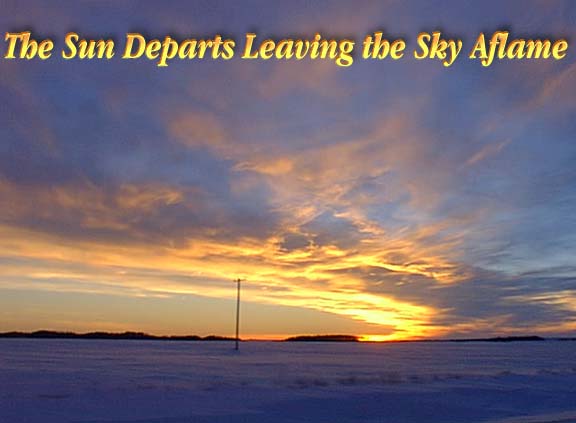
Kinistino to Prince Albert
January 30, 1999
I have to appologise for the size of this page and the length of time it takes for it to load (48 seconds) but my problem is how to give you a sense of this afternoon's departing sun.
There is a sort of sadness that arises from the departure of the sun from the sky each day. Its warmth and light not only provide for our sustenance but carries our spirits with it as well. Some times it seems that the sun is reluctant to leave the day and turn over the sky to night and
 .
.This set of pictures is a sequence each shot one after the other from the van as I travelled from Tisdale to Prince Albert Friday afternoon. The title picture is actual from near the middle of the sequence as it is picture four. So the first image was taken West of Kinistino through the windshield thus giving it and the next image some unwanted anomalies

As all sunsets the terminator (line between light and dark) moves over the earth's surface at one thousand miles an hour at the equator while just around the Mach One at our latitude (Mach is the speed of sound which is relative to the temperature or density of the air but averages just over 600 mph) thus explaining the rapid changes we see from the

These pictures have not been retouched but are just as the CCD in the Epson PhotoPC 500 saw the image and electronically recorded it in digital data. I draw this to your attention because the dramatic difference in light intensity and colour is not only a matter for the sky but with the snow covered ground which is a reflector it also changes colour coordinating

In this image the fingers of red penetrate across the bluing skyscape as the horizon's yellow glow begins to fade




Unfortunately, digital cameras of the type I use and their wide angle lens can not capture the fine subtitles that we see with our eyes for only a few minutes later in that same angle as can be seen at the top of the violet clouds at right appeared Venus, the evening star as the suns light bounced from it across these

The final picture in the sequence is half an hour from the first one and we can see the gaudy advertising image from the Col. Sander's place and a few street lights but the bright white light to the left of the bucket is the heavenly body in charge of the night sky.
The thin high cloud marginally smears the light from the moon only enough to make its image appear in this picture.
By the way, were you to have used a film camera your pictures of this sequence would be even better. Low light and darkness is great to experiment with and you will discover that your film camera and its lens can produce and capture some remarkable things. The most important thing is to learn get your body still and brace your hands so that if the camera's auto exposure timing mechanism kicks in you had hold the camera stable for the exposure. 1/15 of a second is possible with most people and with a wall or fixed object you can hold things stead for longer but it requires practice.
